Miyagi Chojun Memorial Martial Arts Festival
Report and Photos by Terry O'Neill
Text is taken from "Fighting Arts International" #62 (Vol 11, #2)
October 18 - 22,1989
The Supreme Martial Arts Event
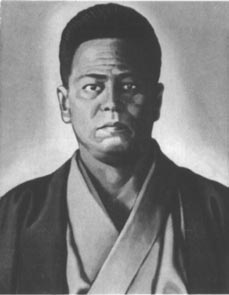
Grandmaster Chojun Miyagi 1888-1953
The Miyagi Chojun Memorial Martial Arts Festival was dubbed 'The Supreme Martial Arts Event'
and the host city, San Diego carries the sobriquet 'America's Finest City' ... but who is
responsible for these plaudits? Well, the first came from the International Okinawan Goju-Ryu
Karate-Do Federation, who organised the event, and the second claim, not unexpectedly, is made by
the Mayor's office in San Diego ... and, as everyone knows, self-praise is (usually) no
recommendation.
Speaking as one who has 'been there and done that' I have to say that the I.O.G.K.F. were nearer
the money 'American terminology for closer to the target' than were City Hall. As Californian
cities go, San Diego was just pleasant - certainly nothing to write home about - but the Miyagi
Chojun Memorial didn't fall far short of its claim.
It really was a tremendous event: five full days of Masters' seminars/clinics, demonstrations and
an international tournament which brought together a legion of martial artists from all over the
world. A grand total of 24 countries were represented, some sending over a full delegation, like
New Zealand with 35 participants, England and Chile - both with 30, Mexico fielded 20, Venezuela 15,
and Japan 10 and so on. Of course, being on home turf, the U.S.A. dominated the numbers game with
450 active participants but the visitors certainly redressed the balance at the two day tournament,
winning 9 out of the 11 'senior' events.
The festival was the brainchild of Morio Higaonna, the internationally acclaimed Okinawan
Goju Ryu Karate sensei. In fairness to him I should point out that 'the supreme event' tag came
from his staff and fellow organizers, not him - his modesty is almost on a par with his outstanding
ability.
Master Morio Higaonna
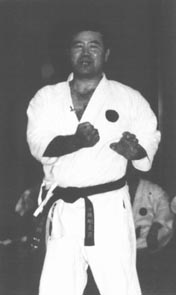
As the name implies, this grand memorial was held in commemoration of the founder of Goju Ryu
Karate, Grandmaster Chojun Miyagi, this being the 101st year since his birth
(those unfamiliar with the Japanese language may wonder what's with the name juggling at this
point - In Nihon-go, the family or surname precedes the given name: so in introducing or writing
down a person's name a Japanese would, for example, do so as Higaonna Morio).
Central to the theme of this festival was the feeling of all martial artists as one family, the
promotion and continued dissemination of karate throughout the world and the promotion of friendship
and technical exchange between budo-ka of different styles and different nations. To this end
the event was a resounding success with 300 seminar participants and over 600 competitors from the
far corners of the globe taking part. That karate has few age barriers was proven by the fact that
competitors ranged in age from 5 years to 73 years.
To make this festival a fitting tribute to one of the great masters, Higaonna invited and arranged
for a number of top martial arts luminaries - all leading authorities in their respective arts -
to teach seminars at the three day special Gasshuku or 'Training Camp' and to demonstrate
their skills at the tournament.
The honoured guest was the Okinawan Goju-ryu master, An'ichi Miyagi. As a foremost protege
of the man the festival was commemorating and the teacher of Morio Higaonna, the founder's namesake
(no relation) had a lot to live up to. This he did admirably: the Okinawan master's detailed
discourses, instruction and demonstrations on the finer points of the Goju-Ryu system were undoubted
highlights for the huge gathering of trainees.
Master An'ichi Miyagi
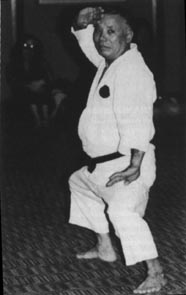
Because of the historical relationship between Goju-Ryu and the martial arts (Wu Shu) of
Fuzhou, Southern China (a subject that Higaonna has been actively engaged in researching for a
number of years now) invitations had been made and accepted by several top masters of the F.W.A.
(Fuzhou Wushu Association) in Mainland China. Very unfortunately, due to recent political unrest in
China, these were unable to make the journey. However one expert instructor of the F.W.A. was able
to attend, being outside the jurisdiction of China. Yan Ling Xing, a master of the
'internal' martial arts, now lives and teaches in Japan and she proved a popular replacement
at the festival. The two classes, in which she taught the 'standardised' (shortened) Tai Chi quan
form, may have looked easy to an observer, particularly one used to the speed and
explosiveness of karate action. They were, however, far from easy: moving slowly with the type of
control and graceful power that this delicate-looking lady exhibited was beyond 99% of the trainees
... actually it was one hundred per cent, I was merely leaving an opening so that readers would
figure that I was the exception.
Also representing the Chinese Martial Arts was Augustine Fong, a leading exponent and teacher
of the Southern Chinese art of Wing Chun. Sifu Fong, who is based in Tucson, Arizona, has 29 years
of experience in Wing Chun and this was apparent in the expert manner in which he introduced and
taught the basic fighting principles of the art to a host of 'first-timers' in the relatively short
period of three hours.
Japanese Martial Arts were represented by a number of distinguished masters, led by three outstanding
karate men: Osamu Ozawa, a direct student of Shotokan Grandmaster, Gichin Funakoshi, is
one of the most senior karate sensei in the world. A staunch traditionalist, Ozawa brought over 50
years of experience in the martial arts to the festival and his absorbing class formed an historical
link with the 'Father of Japanese Karate'; another high-ranking and internationally renowned Shotokan
master was in the line-up, Hirokazu Kanazawa. Thirty two years on since he became the first
fighting champion of the Japan Karate Association, the dynamism and flawless execution of
Kanazawa's technique still makes seasoned karate ka shake their heads in awe; the trio was completed
by the Shito-Ryu stylist, Fumio Demura. After becoming an All-Japan Champion in 1961, Demura
moved to the U.S.A. where he has become one of the most popular and respected karate sensei there.
Even on the strength of the one class I experienced under him, it's easy to see why.
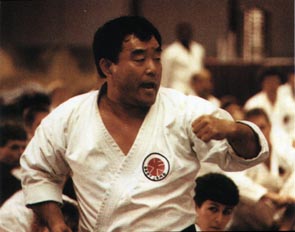
Fumio Demura, the famous Shito Ryu sensei 'cought' midway through his seminar.
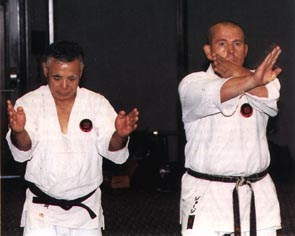
Instruction from the master: George Andrews, an I.O.G.K.F. senior instructor in England
is taught by Miyagi Sensei.
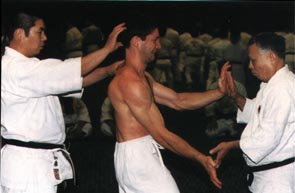
Paul Enfield, one of Higaonna Sensei's senior students undergoes rugged shime (testing)
at the hands of Master Miyagi (at his front) and Kato Sensei at his rear.
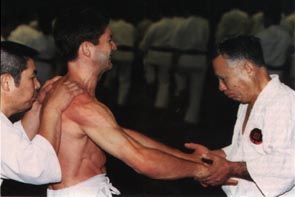
A little more pain for Mr. Enfield!
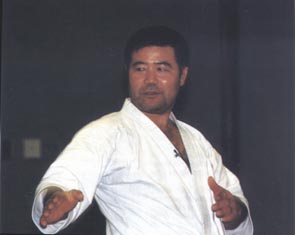
Morio Higaonna, the force behind the Festival and a man most worthy of the title
'Budo Master'.
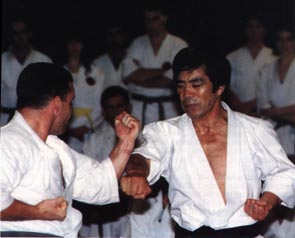
Internationally acclaimed Shotokan sensei, Hirokazu Kanazawa was a very popular guest
instructor and demonstrator at the Festival.
Tetsutaka Sugawara is another sensei who studied under one of the great founders of modern
Budo: he was an uchi-deshi ('inside student' or private disciple) of O'sensei Morihei
Uyeshiba, the originator of Aikido. This teacher is eminently qualified to transmit the
principles of one budo to followers of a completely different 'way': during his 29 years of training,
Sugawara has not only gained a mastery of Aikido but is also a senior in the Tenshin Shoden Katori
Shinto Ryu, a highly revered sword (and traditional weapons) school in Japan. Add to this his
experience in both Goju-Ryu, in which he holds Shodan (1st degree black belt) rank, and Tai Chi quan
and he was an obvious choice for such a difficult task. His three-hour class convinced all present
of the effectiveness of Aikido!
In the position he'd wish to be listed, last, is of course, Morio Higaonna. Suffice it to say
that not withstanding the fact that his teacher was present, along with various men who are 'senior'
to him in budo hierarchy, this is the inverse position to where he would have been had a popularity
poll been conducted amongst the assembled three hundred. The ability and demeanour of this
diminutive Master puts him head and shoulders above many who lay claim to such a title.
The five day festival, which was held at an impressive Holiday Inn venue, right on San Diego Bay, was
preceded by a huge welcoming party on the evening of Tuesday 7th October. At this initial
get-together, countries were introduced and applauded for the effort they had put forth to attend.
The countries officially represented were (in alphabetical order): Argentina, Australia,
Belgium, Bermuda, Canada, Chile, China, Denmark, Dominican Republic, England, Iceland, Israel,
Jamaica, Japan, Mexico, Netherlands, New Zealand, Okinawa, Peru, Portugal, Scotland, Spain,
United States and Venezuela.
The Gasshuku started at 8 am the following morning when 300 gi-clad karate ka bowed in
for the first four hours of Goju-Ryu training. This period was programmed to be split into two
sessions, relieved by a 15 minute break. It never happened. The sensei became so engrossed in the
classes that the rest period never materialized . . . still I suppose it was nice to look forward
to!
Higaonna Sensei lead the training and then split everyone into workable sized groups, according to
their experience. Each group was then assigned a teacher and 'The Boss' was ably assisted in this
respect by the I.O.G.K.F. 'Seniors': Bakkies Laubscher (South Africa); Juichi Kokubo,
Tomoyuki Kato and Kazuo Terauchi (Japan); Leon Pantanowitz (Israel); George
Andrews and Ernie Molyneux (England). Over the three days these instructors would
interchange regularly between the groups. Throughout it all, Miyagi Sensei moved constantly
and untiringly around the vast dojo, pulling out small groups, sometimes just individuals, for
personalised instruction in kata or some other integral aspect of the system. Often during these
morning sessions this senior master would gather everyone around to explain - with Higaonna
translating - some of the principles and history of Goju Ryu, and of his experiences training
under Grandmaster Miyagi.
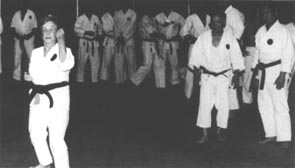
73 year old Karate-ka Irene Seputis performs kata under the watchful eyes of Master Miyagi
and Sudo Sensei.
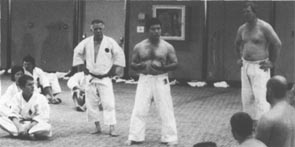
During one of Master Miyagi's lectures, Higaonna Sensei is called upon to
demonstrate a point. On the right is the I.O.G.K.F. Chief Instructor for South Africa,
Bakkies Laubscher.
During the accumulated 12 hours of Goju Ryu, spread over the three days, the seminars focussed
strongly on kata practice and application, including the expected heavy emphasis on Sanchin
training. In fact Miyagi Sensei watched and 'tested' the Sanchin of all the yudansha
(black belts) - some of the lucky ones got second and third treatments! Those who haven't seen
(and heard!) the rugged shime (testing) of Goju Ryu adherents are really missing something.
With this in mind I determined to provide readers with photographs of this aspect of the festival
... unfortunately wielding a camera prevented my being personally tested by this amiable Okinwan,
whose hands descended upon his victim's trapezius muscles like iron shovels. It was hard to forego
such a pleasure but life is full of sacrifices and I instinctively knew that my duty was to the
readers of F.A.I.
Whilst the backbone of the seminars (and indeed of the system itself) was/is the study of kata, the
various Goju Ryu fighting drills like kakie were not neglected either.
After a two hour break for lunch the afternoon and evening seminars were taken by the guest
instructors. There were two separate 90 minute sessions in the afternoon, another two hour break and
then a final two hour training period, from 7 - 9 pm, for those who just hadn't had enough: so
trainees had a possible nine hours a day of specialised martial arts instruction!
The final two days of the festival was devoted to a Traditional Karate Tournament and it was here
that the only hiccup occurred to mar an otherwise problem-free event. Due to the extremely litigious
penchant of the Americans, everyone, including the organisers of martial arts events, are very aware
(scared stiff) of the possibility of having a lawsuit slapped on them by any opportunist who feels
that there has been a violation of rights against themselves, their family, predecessors or even
their pet dog! Consequently when the insurance company, that the I.O.G.K.F. use, stipulated that all
the kumite (sparring) contestants had to wear headguards and foot protectors, along
with the already mandatory fist guards, groin cup (for men) and mouthguard, this was the way it had
to be.
So the situation was that the tournament, which should have been a showcase for traditional karate
- it already had stringent safety measures: the aforementioned mandatory body protection, plus the
rules which disallowed any contact and further stipulated that in all categories for beginners
(8th kyu and below) and the children's under 10 years of age classes, no attacks
would be allowed to the face or head area - took on the appearance of a full-contact meet.
It can be imagined, of course, how popular this ruling was with competitors who had never worn
restrictive helmets, nor had their feet encased in cumbersome and distance destroying 'marsh-mallows.'
If it was any consolation to the traditional competitors, the I.O.G.K.F. were equally as 'pleased'
at having this debilitating imposition forced upon them. Alanna Higaonna told me that after an
extensive search she found that most insurance companies in the U.S.A. were unwilling to insure
karate tournament competitions at all! The next best offer she got, to the one she had to finally
accept, was for spectator liability only. Well the Holiday Inn's insurance policy already covered
this aspect and they, regardless of whether the organisers were willing to take the risk with regard
to participants, were not. The I.O.G.K.F. just had to take what they were offered ... their
alternative was to cancel the tournament. So the tournament was conducted and the competitors and
officials had to make the best out of what they were stuck with. This they all did and it is a
measure of the respect and loyalty felt for Higaonna Sensei that everyone present understood and
accepted the predicament and just got on with it.
A feature of tournaments in the U.S.A. is that there are categories for everyone who can don a
uniform. If it hasn't been done already, I'm sure an enterprising yank will soon devise a little
event in which the mums, dads and grandparents who are non-karate ka, can take a swipe at each
other for a trophy. This is not meant as a criticism, merely an observation because the fact is that
both the competitors and the spectators appear to love it. Virtually the whole family can
'have a go.'
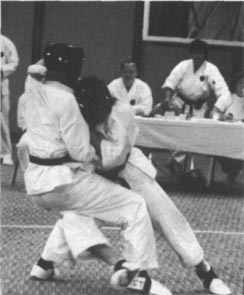
Combatants in the new style Iri Kumi sparring move into grappling range.
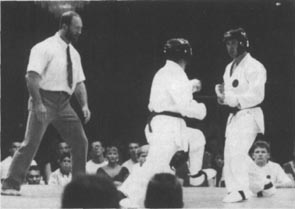
Sunday October 22nd was the senior finals day of the competition. Every contestant in
the Kumite had to wear head, hand and foot protectors.
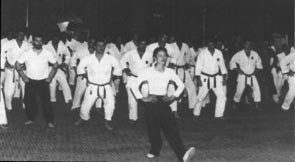
A scene from one of the graceful but gruelling Tai Chi seminars, led by Master Yang Ling
Xing.
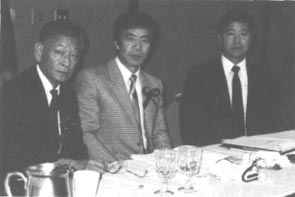
Just three of the outstanding Masters at the Festival. Left to right, Osamu Ozawa,
Hirokazu Kanazawa and Morio Higaonna.
The programme's original quota of 58 events was actualised, once all the entries were in, to 45.
Of these, 19 were Open Kata divisions catering for every age, gender and grade: For example,
Kata Division 1 was for beginners of age 7 and under (boys and girls) ... Division 7
was for advanced contestants of 11-13 years of age (boys only) ... Division 15 was for
intermediates aged 14-17 (girls only) ... Division 24 was for black belts aged 18 and up
(ladies only). A further 4 categories of Goju Kata made up a very comprehensive kata section.
The remaining 22 divisions were all for kumite and these included the same breakdown of elegibility
as in the kata classes ... yes, the first two divisions for age 7 and under (beginners and
intermediates) were mixed - boys and girls.
Unaware of this mixed pairings being part of the 'equal rights' movement in America, I promptly
stopped a match before the first exchange had been made. Just as I was about to reprimand the referee
for not noticing he had a little boy fighting a little girl, it was hurriedly pointed out to me that
this was O.K. in the U.S.A. I blamed jet-lag (I'd been there a week already) and said that, of
course, I already knew that.
I know what you want to know now ... yes, one little girl, Amy Martinez (Shito-Ryu, Chula
Vista, California) did very well and was runner up in the Intermediate/Advanced division of the
Age 7 and Under.
There was a Senior Team Kumite, (comprising three-man teams of brown/black belt status) and two
divisions of a new style of sparring called Iri Kumi. This is a new concept in tournament
fighting, at a traditional karate event anyway, in which competitors tight for one minute non-stop
and the points are tallied up at the end of the match. Iri Kumi is designed to make for a
continuous and, hopefully, more realistic shiai (contest) in which competitors can execute a
variety of techniques in combination without being constantly checked by the 'Yame' ('Stop')
of the usual style karate tournaments.
A competitor can therefore score points immediately after being struck by his opponent. This type of
shiai is particularly well-situated to Goju-Ryu stylists who throw techniques in continuation
and from close-in, a range that, in competitions governed by W.U.K.O. and other World Karate
organisations, it is extremely difficult to score in, due to the match invariably being stopped once
such close proximity occurs between the fighters.
The eliminations for the Iri Kumi were actually held on the Friday, prior to the tournament
proper at the weekend. Probably just as well to keep this concept, whilst it still has a lot of
rough edges to smooth over, out of the general public's view.
The idea in principle is a good one and once the I.O.G.K.F. has fully developed this type of
sparring throughout its many affiliated countries, I'm sure it will catch on and become very popular.
The initial problem of competitors not really knowing what was expected of them, allowing for the
fact that they were suddenly 'armoured up' made for a number of heated and wild exchanges during the
eliminating rounds. As Kanazawa Sensei observed after watching the inaugural bouts
"Once they put it on (the armour) their minds change."
The competitors from England were the best at the new style of sparring and this was obviously due
to the fact that Higaonna Sensei had introduced it to them, some months earlier, on a week-long
Gasshuku. English competitors like Paul Coleman, Ernie Molyneux, Gary
Davis, Roy Flatt, John Boyle, Linda Marchant and Debbie Edwards
showed that, given some experience, the concept of Iri Kumi is a good one and that this form
of shiai can be controlled and developed to a high degree.
All the divisions were completed on the Saturday, with the exception of the Black Belt finals. The
adjudicating and the overall standard of competition was very high and the fact that the whole
tournament ran smoothly and without a hitch, spoke volumes for the amount of preparation and
organisation that had obviously gone into the event. Sunday's finale to the festival attracted a
1,000 strong audience and the finals of the senior competition, along with some stupendous
demonstrations by an array of top-ranking masters made for a spectacular show.
Speaking to Higaonna Sensei the following day, he told me how extremely pleased he was with the
festival. He was surprised and delighted that the attendance was so great and varied from so many
countries around the world. Not only was there great support from his own I.O.G.K.F. members but
from many other styles and organisations as well. He asked me to include in my report how
appreciative he was of the help and support he had received from everyone concerned - all the sensei
who gave such excellent seminars and demonstrations; all the I.O.G.K.F. instructors and instructors
from other styles who gave of their time and talents to make the tournament a success; the staff of
organisers and scorekeepers; and of course the competitors who all worked hard and gave their best
effort.
An'ichi Miyagi Sensei made the comment to him that "Seeing everyone working so hard together to
make this festival such a success would make Grandmaster Chojun Miyagi very happy."
I'll conclude this report with some comments that Higaonna Sensei made when I asked him if he had
any parting message to the festival participants:
"Kata is martial arts and must be kept traditional. We must practice it as it was originally
intended. Kata is the basis of Karate and where the true meaning is to be found.
Kumite, on the other hand, is the individual's own expression and as such it may be researched and
developed by the individual. Variations to kata application in kumite are limitless. There is the
potential for an infinite number of techniques according to the different situations involved, the
practitioner himself/herself, and the opponent that one faces.
Kumite can also be adapted to sport - hence this type of tournament. Sport Karate (tournament) is
fun and can do a lot to bring people together and promote friendship through karate. Even here we
can learn: we must learn to control our feelings, and mind, in order to control our techniques.
"For me the festival's true worth was that even with all the varied styles and countries, the feeling
of togetherness and harmony was unmistakable - a true martial arts family."
Plans are already underway for a follow-up festival in Oct/Nov 1990 ... advance details of this will appear in these pages.
A separate report on the Master's Seminars will appear in the next issue of F.A.I.
Senior results
OPEN
Men's Black Belt Open Kumite:
- Ernie Molyneux (IOGKF, England)
- Kevin Nason (IOGKF, England)
- Jose Guanchez (IOGKF, Venezuela)
- Ron Gordines (Shorin-Ryu, California)
Men's Black Belt Open Kata:
- Alejandro Castro (Venezuela, SKI)
- James Tawatao (Shotokan, Las Vegas)
- Richard Takahashi (Shorin-Ryu, California)
- Mike Kimzey (SKI Way of Japan, California)
Men's Advanced Kata:
- Jose R. Silva (IOGKF, Venezuela)
- Jean Couto (IOGKF Oceanside, Calif.)
- Scott Beavdry (Shotokan, Las Vegas)
- Chris Bold (Shoreikan, Canada)
Men's Advanced Kumite:
- Mirko Buchwald (IOGKF, England)
- Antony Foran (IOGKF, New Zealand)
- Philip White (IOGKF, England)
- Ron Campbell (IOGKF, New Zealand)
Men's Intermediate Kumite:
- Michael Bean (IOGKF, Bermuda)
- Robert Gaddis (IOGKF, Texas)
- Vim Huynh (Shito-Ryu, UCSD)
- Randy Lyle (Kenpo Julian, Calif.)
Women's Black Belt Open Kumite:
- Romania Clavira (SKI Way of Japan, Calif.)
- Kerry May (IOGKF, New Zealand)
- Cyndy Anselmo (Shito-Ruy, Calif.)
- Carol Signorolli (SKI Way of Japan, California)
Women's Black Belt Open Kata:
- Kathy Quan (Shotokan, Quan's Karate, Calif.)
- Karen Lundeen (Shito-Ryu JKO, Calif.)
- Cyndy Anselmo (Shito-Ruy, Calif.)
- Catherine Davis (Shorin-Ryu, NM)
Women's Advanced Kata:
- Francesca Buzzolo (IOGKF, Chile)
- Debbie Mathews (ITK IOGKF, San Marcos)
- Deborah McCormick (Shorin-Ryu, Las Vegas)
- Patty Truman (Shotokan, Las Vegas)
Women's Advanced Kumite:
- Yvonne Murillo (IOGKF, Venezuela)
- Brit Fredricksen (IOGKF, Denmark)
- Francesca Buzzolo (IOGKF, Chile)
- Regina Petzold (IOGKF, Chile)
'IRI KUMI' (IOGKF KUMITE)
Men's Black Belt:
- Paul Coleman (IOGKF, England)
- Jose Guanchez (IOGKF, Venezuela)
- Ernie Molyneux (IOGKF, England)
- Gary Davis (IOGKF, England)
Women's Black Belt:
- Kerri May (IOGKF, New Zealand)
- Terry Reynaga (IOGKF, Calif.)
- Linda Marchant (IOGKF, England)
- Debbie Edwards (IOGKF, England)
GOJU-RYU KATA
Men's Black Belt:
- Luis Nunes (IOGKF, Spain)
- Carlos Gimenez (IOGKF, Spain)
- Katsuya Yamashiro (IOGKF, Okinawa)
- Takafumi Hamabata (Goju-Ryu, Calif.)
Men's Brown Belt:
- Jose R. Silva (IOGKF, Venezuela)
- Robert Joe (IOGKF Honbu, New Zealand)
- Andrew Lock (IOGKF, New Zealand)
- Antony Foran (IOGKF, New Zealand)
Women's Black Belt:
- Hitomi Okada (IOGKF, Japan)
- Kerry May (IOGKF, New Zealand)
- Helen Giragosian (Chuck Merriman Karate International, Calif.)
- Christine Garnier (Shito-Ryu, Los Angeles)
Women's Brown Belt:
- Britt Fredriksen (IOGKF, Denmark)
- Sharon Clinch (IOGKF, England)
- Yvonne Murillo (IOGKF, Venezuela)
- Becky Kuhn (Japan Goju, San Diego)